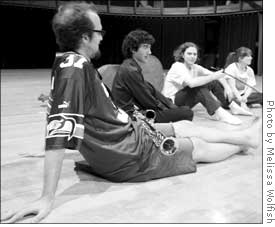
| << Front page | Arts | April 28, 2006 |
Ensemble 46 Expands Artistic Limits
Innovative Dance/Music Group Transcends
Genres
 |
||
| Dancers and Musicians Unite: Senior Johnny Butler meeting for practice with fellow members of Ensemble 46, an on campus improv group that seeks to fuse dance and music. | ||
Every week, five dancers and five musicians come together to engage in extended improvisation. The only continuing improv group of its kind on campus, Ensemble 46 serves to explore the medium and create a bridge between dance and music improvisation.
Composed of dancers senior Tatyana Tenenbaum, sophomores Lucy Segar and Sarah Hymanson, and first-years Hannah Verrill and Alesandra Zsiba, along with musicians first-year Andrei Pohorelsky on piano, seniors Matt Nelson and Johnny Butler on saxophone, junior Josh Morris on bass and senior Jake Wise on clarinet, the group formed at the beginning of this semester and hopes to continue into the next.
“The group is the continuing exploration of the relationship between music and dance,” said Tenenbaum, the initial organizer. “I wanted to establish a group that improvises more than once, that could come to know each other...to [serve as a] change from the one-on-one relationship that usually happens with improv.”
The improvisation sessions usually begin with setting a score, or structure to follow. The guidelines that the score sets help the dancers and musicians have direction for their improv and ideally challenge them to experiment. An audience is not necessarily supposed to pick up on the score — rather, it is intended to direct the improvisers.
“The score gives [the improv] a purpose,” said Zsiba. “It makes [improvising] more satisfying to do...[and gives us the chance] to break our habits.”
In many settings, improvisation like this occurs on a smaller scale without participant regularity. Ensemble 46 hoped to break from this standard. The nature of the group helps its members develop relationships and establish comfort among them.
“The consistency of people working together establishes a real sense of each other’s identities,” said Pohorelsky.
The connection among improvisers serves the group’s creative purposes as well. The consistent group setting enables the dancers and musicians to explore their arts in ways ordinarily unavailable to them.
“Improvisation is personally so necessary for me,” said Verrill. “It gets your mind to work in a way that it wouldn’t otherwise. Improvisation exercises the muscles you need for composition or choreography, only [in improv] you don’t have to commit to anything, to an idea; it’s impulsive, transitive.”
The improvisers appreciate the medium that they have created for the opportunity it gives to expand their practices and explore new connections.
“Usually music and dance and other mediums exist in their own worlds,” said Morris. “When the different spheres collide, you generate something that you wouldn’t have otherwise.”
The group hopes to further this collision into other areas as well, such as visual art and theater, making it more established and cross-disciplinary in the future. Because of the positive feedback that the group is already enjoying, this seems to be a realizable goal.
“People here have been really receptive and excited about it,” said Segar.
The Oberlin community is not the sole source of excitement; the dancers and musicians share in it. The experience has been an opportunity for them to learn as well.
“It made me aware suddenly that everything I do is part of the piece,” said Wise. “I’m not used to thinking like that, but once you realize it, it changes everything and you can’t go back. Usually when you play, you’re just playing, and movement doesn’t matter.”
Saxophonists Butler and Nelson experienced similar changes.
“I dance more at my gigs now,” said Butler.
“The group affected me as a dancer,” said Nelson. “I had never thought of how music related to movement.”
The dancers, too, have undergone changes as a result of the group.
“I had the least experience dancing, of the dancers, and they’ve been really supportive,” said Hymanson. “But I’ve been able to take this with me into my acrobatics.”
Improvisation of this sort in a performance setting was something new for some of the group. Public performances were not within the original intentions.
“Dance improvisation as performance is unique,” said Segar. “But we evolved into a performance group... It makes you think differently about what a dance performance is and what music performance is.”
The performances have been both an evolutionary and cyclical process, changing as the members grow to understand each other, yet existing under the notion of improvisation’s inconstant nature.
When the group first started improvising together, for example, the musicians did not move or interact with the dancers to a great extent. However, as time progressed, both the dancers and musicians began to feel more comfortable interacting with each other.
“Our [initial] hesitancy turned into confidence,” said Segar.
Ensemble 46’s presence at Oberlin serves to connect various creative
expressions. Continuing along its current path, it could set the score for
future artistic risks. Ensemble 46 will perform on Wednesday, May 3 in Warner
Concert Hall for the TIMARA concert at 8 p.m. and on Thursday, May 4 at the
Cleveland Spaces Gallery from 5-10 p.m.
About us
Subscriptions
Advertising